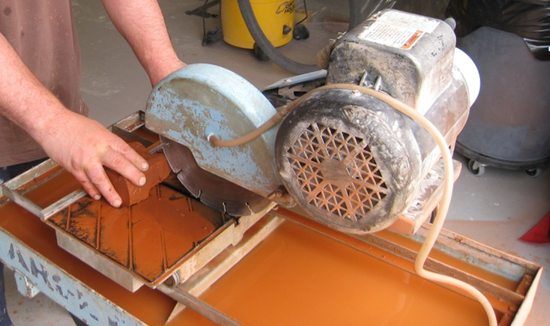Freeze-Thaw Risk: Material Testing
Back to Recommended Freeze-Thaw Risk Assessment Steps
In many projects, the risk is not clear from inspection alone. Material testing is the next step in evaluating risk. Samples are removed from the building being assessed and shipped to our lab.
Lab tests can include dry density, A-value (absorption or liquid water uptake rate), and saturation moisture content (storage). However, the primary method used by BSC to assess the risk of freeze-thaw damage is frost dilatometry. Frost dilatometry, as first developed by Fagerlund1, involves putting thin slices of brick through multiple freeze-thaw cycles until damage is measurable. This process produces a measure of Scrit (the Critical Degree of Saturation) – the point of saturation at which a given masonry material will fail. By estimating the typical degree of saturation for a building, and comparing it to Scrit, the risk of freeze-thaw damage can be predicted. Freeze-thaw cycling below Scrit has low risk of damage, but above Scrit, damage can occur after relatively few freeze-thaw cycles.
Unlike methods that provide pass-fail measures of freeze-thaw “resistance”, the frost dilatometry approach allows the material resistance to be compared to predicted moisture loading and ambient temperatures. A wall on the edge of a cliff overlooking the ocean will see a great deal more driving rain than a wall in a sheltered neighborhood in the mid-west. So instead of a brick simply “passing” or “failing,” different brick can be suitable for one exposure but not the other.
In other words, this method produces realistic, usable data – data that can inform decision-making. Refining this methodology for commercial applications has been a significant part of BSC’s freeze-thaw research2.
Next Steps
- If available data about environmental conditions is adequate, use hygrothermal modeling to assess the predicted rain load relative to Scrit. Go to: Hygrothermal Modeling.
- If additional site load data is needed, gather it. Go to: Site Load Assessment.
- In some cases, materials testing in combination with a site visit can provide a good indicator of risk. For example, if testing reveals a critical saturation point close to its free water saturation, and the building’s rain exposure is likely to be low, an experienced consultant may be able to judge freeze-thaw risk without the need for hygrothermal modeling. Go to: Repair/Retrofit, Maintain and Monitor.
1Fagerlund, G., “The critical degree of saturation method of assessing the freeze/thaw resistance of concrete”, Journal of Structures and Materials, 10.58, pp 217-229, 1977.
2For a more detailed account of this method, see Straube, Mensinga, and Schumacher, “Assessing the Freeze-Thaw Resistance of Clay Brick for Interior Insulation Retrofit Projects”, Thermal Performance of the Exterior Envelopes of Whole Buildings XI International Conference, December 5-9, 2010 in Clearwater, Florida.

